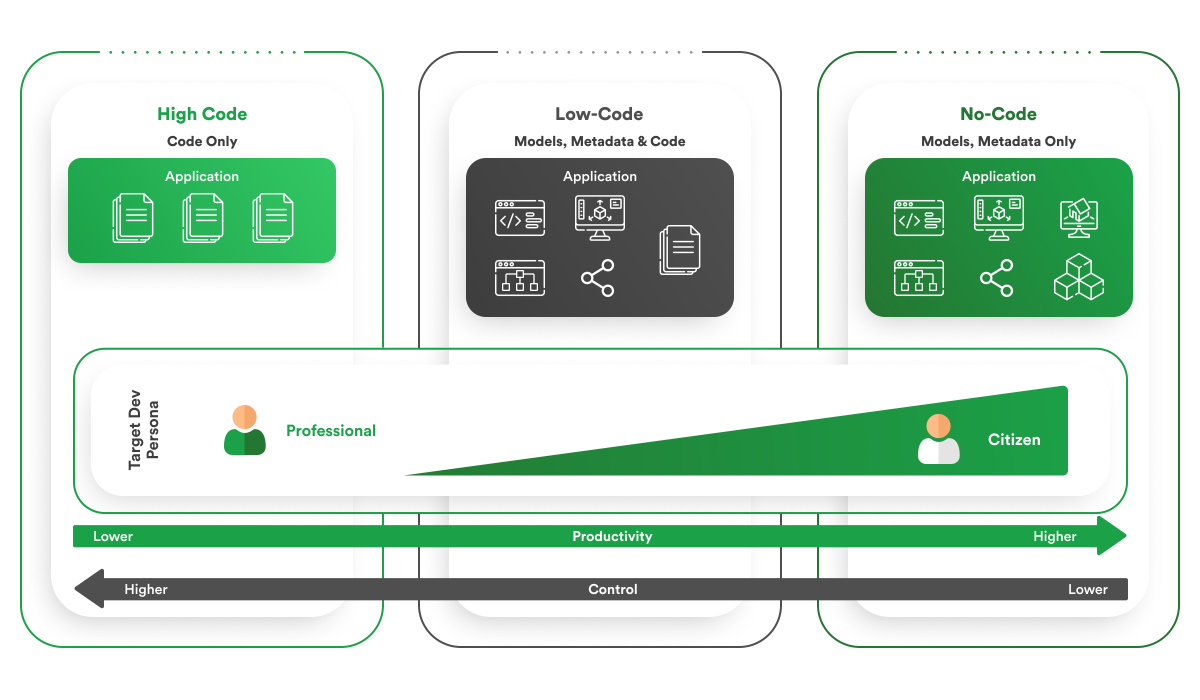
Omnichannel Retail: Technologies, Challenges, and Opportunities
This article explores omnichannel retail. It covers its advantages, the technology driving it, the implementation challenges companies face, and future trends.
According to Gartner, by 2025, 70% of new applications developed by enterprises will use low-code or no-code technologies. By 2030, the global low-code/no-code development platform market is expected to generate $187 billion in revenue and account for more than 65% of application development activity by 2024. Retailers are leveraging these platforms to speed up development, reduce costs, and streamline business processes.
This article delves into the nuances of no-code and low-code platforms, with a focus on their application in retail tech solutions development. It will discuss the optimal scenarios for leveraging these technologies and examine the constraints they may present.
No-code development platforms enable the creation of applications without requiring any coding expertise. These platforms offer a range of pre-built modules and drag-and-drop interfaces, allowing users to create functional applications rapidly. They are ideal for users with limited or no coding skills, allowing them to participate actively in the software development process.
Low-code platforms are development environments that require minimal coding. They primarily use Graphical User Interfaces (GUIs) for constructing applications. These platforms offer more customization capabilities than no-code platforms but may require some coding for more complex functionalities.
While both no-code and low-code platforms aim to expedite the development process, they differ in the level of customization they offer and the skill level they require. No-code media are generally used for more straightforward applications. Anyone can wield them, while low-code platforms are used for more complex applications and may require a basic understanding of coding concepts.

Before the rise of low-code and no-code platforms, traditional approaches involving human coding, frequently from scratch, were the foundation of retail software development. Long development, testing, and deployment cycles were required for this, which increased costs and prolonged the time to market. Smaller retailers suffered the most because they struggled to compete with larger companies that could afford to spend a lot of money on complex custom software solutions.
Retailers began searching for more flexible approaches to create applications that could be swiftly launched and refined as the digital transformation increased. As a fix, low-code and no-code platforms were introduced. These platforms made software development more accessible and affordable, increasing the competitiveness of all businesses, regardless of size. Now, a single-store retailer can develop applications just as functional as those created by a multinational chain, thereby leveling the playing field.
The speed at which applications may be developed and deployed is one of the most attractive features of low-code and no-code platforms. Being first to market might be a significant advantage in an industry where customer preferences change often. Instead of waiting months, retailers may swiftly adjust to market changes, roll out promotions, or add new sales channels.
A team of skilled developers, designers, and other IT specialists is frequently necessary for traditional development, which raises operating costs. Platforms with low code and no code significantly lower these expenses. Retailers can reduce the cost per project by decreasing the size of their development team or enabling current employees to take on these tasks.
Retailers frequently adjust quickly to shifting consumer preferences, rival tactics, or legislative changes. Platforms with low- and no-code allow for easy application modification. This flexibility often extends to backend processes and the user interface, enabling a more thorough and quick reaction to change.
In the past, when non-technical employees needed assistance with software, they had to go through IT departments, frequently resulting in bottlenecks. Employees without technical expertise can create or alter apps on low-code and no-code platforms. This autonomy expedites decision-making procedures and cultivates an innovative culture within the company.
Companies need to grow quickly due to the retail industry’s intense competition. Businesses frequently must test several theories before developing an approach that works. Conventional development cycles should be shorter to allow for this kind of quick experimentation. Retailers can quickly create prototypes to test business ideas or user experiences with low-code and no-code platforms. These early versions could be anything from interactive kiosks for in-store use to customized recommendation engines for online use.
By enabling quick iterations, these platforms allow retailers to experiment without a significant investment of time or resources. Once the feature or application is validated, it can be scaled using the same forum or as a proof-of-concept for more traditional development methods. This speed and flexibility are especially crucial in online retail, where customer behavior metrics can provide real-time feedback and application adjustments can be made on the fly.
Each retailer has different requirements according to its target market, selection of products, and business plan. Often, generic software solutions need more features to meet these needs. Low-code platforms provide a compromise between fully customized solutions and off-the-shelf software because they can support some custom coding.
Customization is also available with no-code platforms but only for pre-built modules. Retailers needing more straightforward solutions customized to meet their business demands will find them especially helpful. A small boutique may find tracking sales and stock levels with a clear, custom solution more beneficial than implementing a complex inventory management system.
Most retailers do not start their digital transformation from scratch. They often have legacy systems (be it for inventory, CRM, or point-of-sale) that contain valuable data and business logic. However, these systems can be complex and may not integrate well with newer technologies. No-code and low-code platforms can seamlessly bridge legacy systems and new applications, enabling retailers to modernize without disrupting existing operations.
By providing connectors, APIs, or other integration options, these platforms make it possible to sync data between old and new systems, often without the need for extensive coding. This extends the life of legacy systems and ensures that the organization can transition smoothly into using more modern applications.
Marketing, sales, and customer service teams often have software needs that are urgent but not complex enough to require the full attention of an already stretched IT department. For example, the marketing team may need a simple application to track the effectiveness of an ongoing campaign, or the customer service team might require a tool to manage customer feedback effectively.
No-code and low-code platforms allow these non-technical teams to build the tools they need without waiting in the IT queue. Empowering these teams to solve their software speeds up processes and frees the IT department to focus on more complex, organization-wide issues. This agile approach to problem-solving can be a significant competitive advantage in a fast-paced retail environment.
Step one towards a successful implementation is choosing a suitable low-code or no-code platform. Retailers should consider scalability, security, and integration capabilities when evaluating media based on their unique requirements. Scalability is essential for retailers anticipating growth or seeing seasonal changes in demand. If the platform is easily scalable, the retailer will stay within its development environment too soon.
Security is another essential factor, given that retail applications often handle sensitive customer data and financial transactions. Retailers should look for platforms that comply with industry regulations, such as PCI DSS for payment processing and GDPR for data protection. Finally, integration capabilities are vital, especially for retailers with existing legacy systems. The chosen platform should be able to connect seamlessly with the existing tech stack, whether through pre-built connectors, APIs, or custom integrations.
Every new technology that is implemented in a company has a learning curve. Even though low-code and no-code systems are meant to be user-friendly, to utilize them fully, training is typically necessary. Retailers need to think about starting training programs and continuing their education. While continual training ensures users are informed about upgrades, new features, and best practices, initial training brings users up to speed on the platform’s essential features and functionalities.
Many platform providers provide extensive training resources, including webinars, documentation, and video tutorials. These resources can be added to internal training programs. Involving a core group of early adopters can also aid in developing internal expertise that can be shared across the entire company.
Best practices must be followed to successfully deploy and maintain low-code and no-code apps. Retailers should begin small with a pilot project to learn about the platform’s features and restrictions. This method enables real-world testing and provides insights to direct deployment on a larger scale.
Even though it’s a concept borrowed from traditional software development, version control is also crucial in a no-code and low-code environment. Retailers should keep track of changes, updates, and application modifications, especially when multiple team members are involved in the development process. Moreover, regular audits and performance monitoring should be routine practice. These can help retailers understand their applications’ performance regarding speed, uptime, and user engagement and can offer valuable data to guide future development efforts.
Although low-code and no-code platforms are more affordable and provide quick implementation, they do not necessarily scale well as a company expands. Retailers may discover that their first platform cannot support the additional load or provide the necessary functionality as their client base grows or as they enter new markets. It can mean spending more money and time switching to a more reliable system.
Planning is essential because of this potential disadvantage. Retailers should assess a platform’s long-term scalability by considering future and present requirements. Evaluating the platform’s architecture and capabilities in light of planned expansion might involve connecting with the platform vendor and seeking advice from IT specialists.
Due to the volume of customer information and financial transactions carried out daily, data security is crucial in the retail industry. Trustworthy low-code and no-code platforms typically include strong security protections but might only address some aspects of industry-specific laws. Furthermore, vulnerabilities may be introduced by third-party components embedded into apps.
It is recommended that retailers perform routine security audits and updates to detect and mitigate any potential issues. Additionally, it’s imperative to confirm that any platform selected conforms with applicable industry standards and laws, such as PCI DSS for payment processing and GDPR for consumer data.
Although extensive, the degree of customization offered by no-code and low-code platforms is limited to the capabilities and modules that the platform provides. Some retailers may find these restrictions unpleasant if they have particular demands. Low-code platforms may not be as flexible as a fully custom-built solution, even though they allow for greater customization options through manual coding.
Striking a balance between the needs for specific features and the pre-built functionalities’ convenience takes time and effort. Retailers need to be very clear about what they need and assess if a low-code or no-code platform can fulfill these objectives or if a unique solution is required.
There are risks associated with relying too much on a single platform provider, including reduced customization options, loss of cost management, and possible migration challenges. In addition to the operational difficulties of data migration, switching systems may require extensive staff retraining.
When choosing a platform, assessing the partnership’s long-term viability and considering data portability and interoperability possibilities is critical. The objective is to maximize the advantages of no-code and low-code media while minimizing dependency on a single vendor.
Despite the claims made by multiple platforms regarding their simple interface with modern systems, the truth may be more nuanced. Retailers may need help integrating new applications with third-party software or outdated systems. Limitations may also arise from depending too much on third-party connections and plugins, which may only sometimes be updated or supported over time.
To lessen this, retailers can search for platforms with deep native integration capabilities. They should also consider the third-party components they want to use and their long-term support and update policies.
The technology landscape is ever-changing, and there’s a risk that a chosen platform could become obsolete or unsupported. Continuous updates and maintenance are necessary for long-term viability. Retailers should consider the initial implementation and the ongoing costs and resource allocation required to keep their applications current and effective.
Because no-code and low-code platforms are so easy to use, people occasionally wrongly believe that no expertise or experience is needed to use them efficiently. This is untrue because developing successful solutions requires an awareness of best practices in various fields, including process automation, data modeling, and user experience design.
A certain amount of experience is still required, even though the technical skills needed are less than in traditional development. Shops should pay for training initiatives to guarantee that their staff members can take full advantage of these platforms.
Low-code and no-code solutions might only sometimes perform as well as custom-built programs, mainly when dealing with complicated tasks or large-scale activities. There may be performance bottlenecks, which will affect the user experience.
It is imperative to carry out routine performance monitoring and optimization. Retailers should track application performance using analytics and other monitoring tools, adjusting as necessary to guarantee optimal speed and dependability.
With the availability of low-code and no-code solutions in retail, it is clear that these platforms offer the industry revolutionary possibilities. They provide the efficiency, adaptability, and affordability that today’s competitive retail environment requires. As with any technical adoption, moving forward with complete awareness of potential drawbacks and difficulties is essential. Concerns about scalability, security, and customization restrictions are crucial factors that call for a comprehensive strategy and a balanced approach.
Retailers may significantly reduce these risks by proactively selecting the appropriate platforms, allocating resources for training, and following best practices. By doing this, they set the stage for long-lasting and successful technological applications and provide the tools they need to adapt quickly to the changing retail environment.
This is the perfect time to take action if you’re considering implementing low-code or no-code solutions for your retail operations. Take advantage of the experience of a seasoned software development company that is aware of the challenges and prospects within the retail sector. If these platforms are correctly implemented, they can give you a significant competitive edge by allowing you to react quickly to changes in the market, decrease costs, and improve your ability to innovate.

This article explores omnichannel retail. It covers its advantages, the technology driving it, the implementation challenges companies face, and future trends.

A comprehensive overview of how fintech innovations drive significant changes in the retail industry.

In this article, we explore a current retail technology landscape and trends shaping the industry, retail tech use cases, as well as what the future holds for retail tech.
Copyright © 2023 rinf.tech. All Rights Reserved.
Terms & Conditions. Cookie Policy. Privacy Policy.
Politica Avertizari de Integritate (RO)